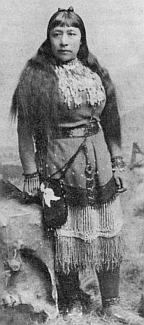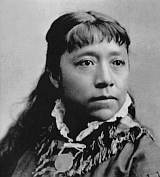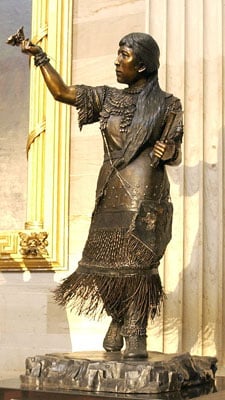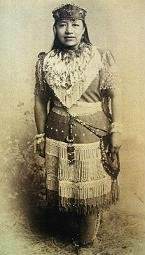Sarah Winnemucca
Sarah Winnemucca (1844-1891) was born Thocmentony, a Paiute name that means Shell Flower. She was a peacemaker, teacher, interpreter, scout, and defender of the rights of Native Americans. She was notable for being the first Native American woman to secure a copyright and to publish in the English language. She was also known by her married name, Sarah Winnemucca Hopkins, under which she published her book, Life Among the Paiutes: Their Wrongs and Claims, an autobiographical account of her people during their first forty years of contact with explorers and settlers.
At the time of her birth the Paiutes of western Nevada had only very limited contact with Euro-Americans; however, Winnemucca spent much of her adult life in white society. Many Paiutes viewed her as a collaborator who helped the U.S. Army kill her people. Modern historians view her book as an important primary source, however one known more for its heartfelt descriptions of her peoples' plight than for its historical detail. Winnemucca's pioneering activism has only recently received positive attention and in 2005 a statue of her was added to the National Statuary Hall Collection in the U.S. Capitol.
Early life

Born "somewhere near 1844" at the Humboldt Sink in what is now western Nevada, Sarah Winnemucca was the daughter of Chief Winnemucca (Poito). Her father was a shaman and her grandfather, being a recognized chief of the northern Paiutes, helped to earn her the nickname from the press of "Paiute Princess".
Winnemucca's grandfather, Chief Truckee, was enthusiastic about the arrival of white people in the western part of the United States. He guided John C. Frémont during his 1843-45 survey and map-making expedition across the Great Basin to California. Later he fought in the Mexican-American War, earning many white friends. Winnemucca's initial experience of white people was one mixed with awe and fear. Her grandfather took her on a trip to the Sacramento, California area (a trip her father, who remained skeptical of whites, refused to make). Later her grandfather placed her in the household of William Ormsby of Carson City, Nevada to be educated. Winnemucca soon became one of very few Paiutes in Nevada able to read and write English.
William Ormsby was later killed in action at the first battle of the Pyramid Lake War when the militia force he led was annihilated by a Paiute force led by Winnemucca's cousin Numaga. Her book tells how her brother Natchez unsuccessfully tried to save Ormsby by faking his death. Her father and brother both fought on the Paiute side.
After the war her family moved to the Malheur Reservation which was designated a reservation for the Northern Paiute and Bannock Indians by a series of Executive Orders issued by President Ulysses S. Grant. Winnemucca taught in a local school and acted as interpreter for Indian Agent Samuel Parrish. Parrish worked well with the Paiutes and established a coherent and well-managed agricultural program.
Bannock War
After four years Parrish was replaced by agent William Rinehart, who alienated many tribal leaders when he failed to pay Paiute workers for agricultural labor in commonly held fields. Conditions at the Malheur Reservation quickly became intolerable. Winnemucca's book tells how the Indian Agent sold many of the supplies intended for the people to local whites. Much of the good land on the reservation was also illegally expropriated by white settlers. In 1878 virtually all of the people on the reservation left in order to find better land and another source of subsistence. The Bannock tribes then began raiding isolated white settlements in southern Oregon and northern Nevada, triggering the Bannock War.
During the Bannock War, Winnemucca worked as a translator for the U.S. Army. In her book she describes scouting and message-carrying duties that she performed on behalf of the Army. Her description of engagements is frequently comical - according to her account the Bannock and the Army soldiers liked each other so much that they rarely shot to kill. Sarah was highly regarded by the officers she worked for, and her book includes letters of recommendation from several of them.
In her autobiography, she recounts the story of raiding a Bannock camp at night in order to rescue her father and brother who were being held captive. She said of this brave escapade, "It was the hardest work I did for the army."
Yakama Reservation
Following the Bannock War, the Northern Paiute bands she was associated with were deemed untrustworthy and forced to march to the Yakama Indian Reservation (in Washington Territory), where they endured great deprivation. Winnemucca went with them to serve as a translator even though her position did not require her to live on a reservation. Upon observing the plight of her people she began to speak out in lectures she gave across California and Nevada. During the winter of 1879 and 1880, she and her father visited Washington D.C. and gained permission from Secretary of the Interior, Carl Schulz, for the Paiutes to return to Malheur at their own expense. They also met briefly with President Rutherford B. Hayes. However, the promise of land at Malheur Reservation went unfulfilled for years. Winnemucca was bitterly disappointed by the orders from agent Wilbur stating that her people could not leave the Yakama Indian Reservation:
- Knowing the temper of the people through whom they must pass, still smarting from the barbarities of the war two years previous, and that the Paiutes, utterly destitute of everything, must subsist themselves on their route by pillage, I refused permission for them to depart . . . and soon after, on being more correctly informed of the state of affairs, the Hon. Secretary revoked his permission though no determination as to their permanent location was arrived at. This was a great disappointment to the Paiutes and the greatest caution and care was necessary in dealing with them.
- Report of Yakama Agent, James H. Wilbur
- Annual Report of the Commissioner of Indian Affairs for the Year 1881, p. 174 and 175.
- American Indians of the Pacific Northwest
In 1884, she traveled to the East Coast once again, in order to testify before Congress. She asked that the Paiutes be given lands and citizenship. She also spoke before the Senate Subcommittee on Indian Affairs. On July 6, 1884 the Senate passed a bill which enabled the Paiutes to return to Pyramid Lake but not to their preferred location, the Malheur Reservation.
Lectures and writing
While lecturing in San Francisco, California, Sarah met and married Lewis H. Hopkins, an Indian Department employee. (She had two previous short-lived marriages to white men.) In 1883, they traveled east where Sarah Winnemucca-Hopkins delivered nearly three hundred lectures. In Boston, the sisters Elizabeth Peabody and Mary Peabody Mann, wife of the educator Horace Mann, began to promote her speaking career. The latter helped her to prepare her lecture materials into Life Among the Paiutes, which was published in 1883.
Sarah's husband supported his wife's efforts by gathering material for the book at the Library of Congress. However, her husband's tuberculosis combined with his gambling addiction left Winnemucca with little financial means.
After returning to Nevada Winnemucca-Hopkins pursued her dream of building a school for Indian children, hoping to promote the Indian culture and language. The school was forced to close after a few years when the Dawes Act of 1887 was passed. The Act granted Native Americans citizenship, while also requiring Indian children to attend English-speaking boarding schools. Despite a bequest from Mary Peabody Mann and efforts to turn the school into a technical training center, Winnemucca-Hopkin's funds were depleted by the time of her husband's death in 1887, and she spent the last four years of her life retired from public activity. She died at her sister's home in Henry's Lake, Nevada of tuberculosis. She was 47 years old.
ReferencesISBN links support NWE through referral fees
- Winnemucca, Sarah, Life Among the Paiutes: their wrongs and claims, University of Nevada Press (1994) ISBN 0874172527
- Morrison, Dorothy Nafus, Chief Sarah: Sarah Winnemucca's Fight for Indian Rights, Oregon Historical Society Press (1991) ISBN 0875952046
- Canfield, Gae Whitney, Sarah Winnemucca of the Northern Paiutes, University of Oklahoma Press (1988) ISBN 0806120908
- "Sarah Winnemucca." Historic World Leaders. Gale Research, 1994 Reproduced in Biography Resource Center. Farmington Hills, Mich.: Thomson Gale. 2006.
- Contemporary Authors Online, Gale, 2006. Reproduced in Biography Resource Center. Farmington Hills, Mich.: Thomson Gale. 2006.
- "Sarah Winnemucca." Encyclopedia of World Biography, 2nd ed. 17 Vols. Gale Research 1998. Reproduced in Biography Resource Center. Farmington Hills, Mich.:Thomson Gale. 2006.
Further Reading
- Brown, Dee, Bury My Heart at Wounded Knee, Henry Holt & Co. (1970) ISBN 0805066349
External links and references
- Life Among the Paiutes: Their Wrongs and Claims by Sarah Winnemucca Hopkins (1883). Full text online by Dan Anderson, 2005.
- Biography, from the website of Nevada Women's History Project at the University of Nevada, Reno
- Voices from the Gaps: Sarah Winnemucca Hopkins, a biography from a University of Minnesota website
- Biography from the National Women's Hall of Fame website
- Nevada Historical Marker 143 on Thocmetony, from a state of Nevada website
Credits
New World Encyclopedia writers and editors rewrote and completed the Wikipedia article in accordance with New World Encyclopedia standards. This article abides by terms of the Creative Commons CC-by-sa 3.0 License (CC-by-sa), which may be used and disseminated with proper attribution. Credit is due under the terms of this license that can reference both the New World Encyclopedia contributors and the selfless volunteer contributors of the Wikimedia Foundation. To cite this article click here for a list of acceptable citing formats.The history of earlier contributions by wikipedians is accessible to researchers here:
The history of this article since it was imported to New World Encyclopedia:
Note: Some restrictions may apply to use of individual images which are separately licensed.


